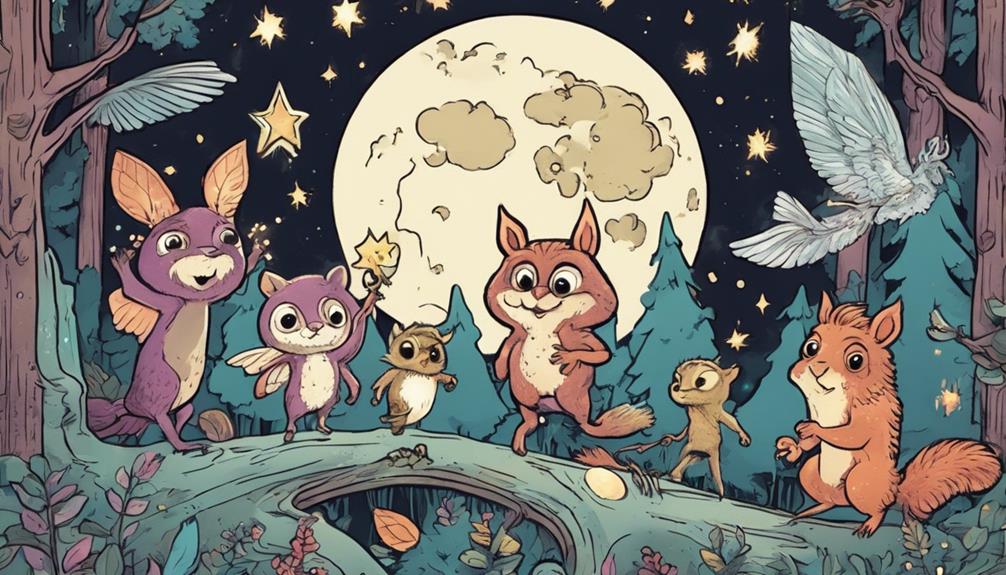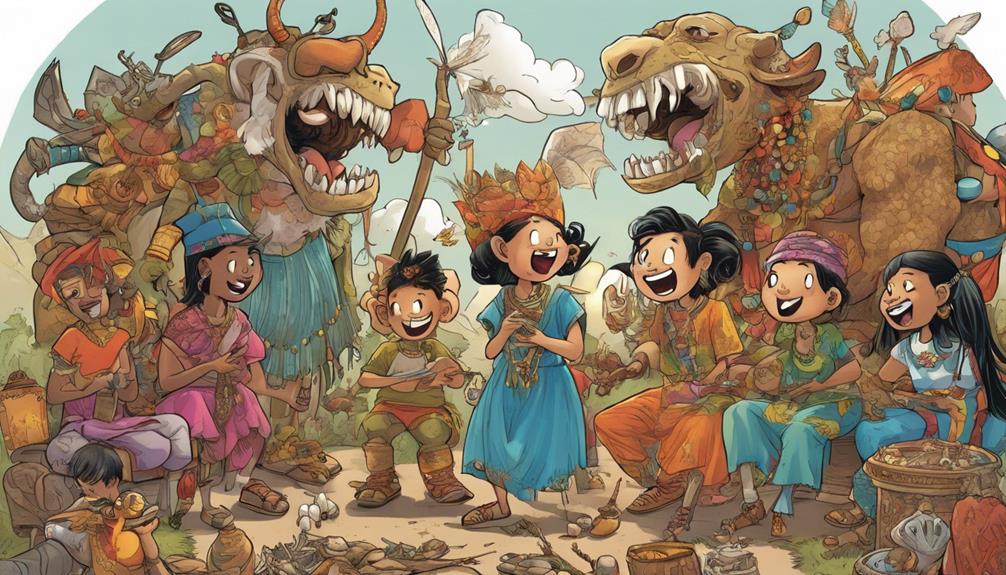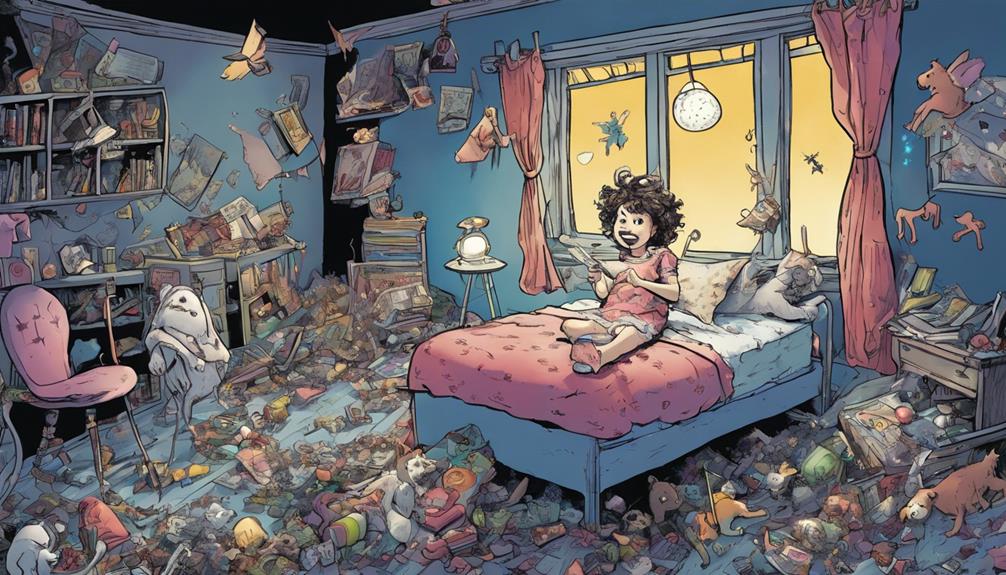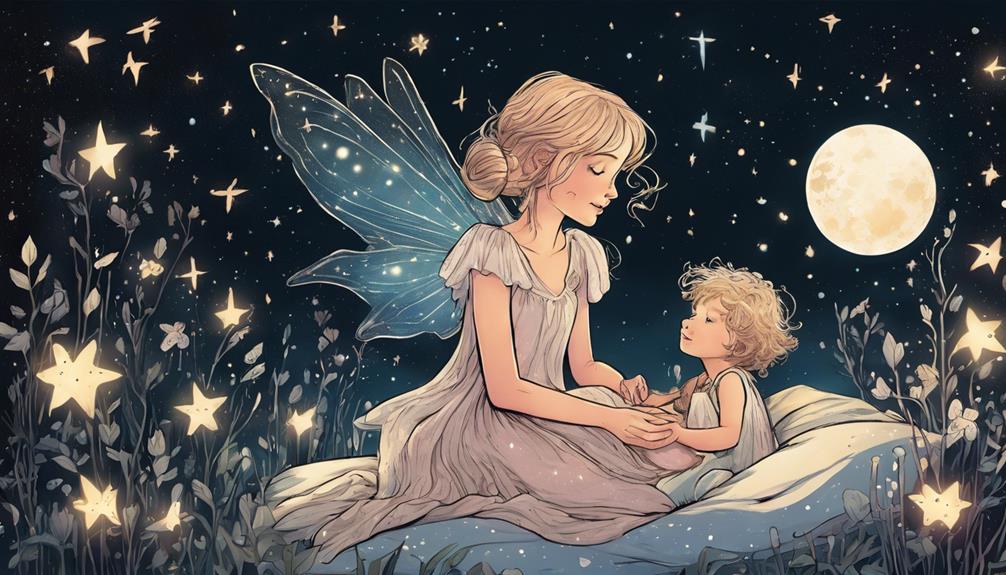You might be surprised to learn that the Tooth Fairy has some unexpected allies helping her out. Across the globe, you'll find charming mice like Ratoncito Pérez in Spain and La Petite Souris in France, both collecting lost teeth. Birds play a role in Brazil, where children toss teeth outside for them, while Indian traditions involve placing teeth on rooftops for sparrows. Additionally, guardians like Jack Frost collaborate to protect children's dreams during these tooth exchanges. Together, they create a magical world that enhances childhood milestones, and there's so much more to explore about these enchanting allies.
Key Takeaways
- The Tooth Fairy collaborates with animal helpers like La Petite Souris, Ratoncito Pérez, and birds to collect lost teeth across various cultures.
- Guardians such as Jack Frost and Sandy support the Tooth Fairy by protecting children's dreams and ensuring a peaceful sleep during tooth collection.
- Mini-Fairies play a role in assisting the Tooth Fairy, gathering teeth under moonlight while nurturing dreams for sleeping children.
- Cultural variations highlight different allies, such as birds in Brazil and lizards in Africa, emphasizing local beliefs surrounding tooth loss and collection.
The Tooth Fairy's Origins

Tracing back through various cultures, the origins of the Tooth Fairy reveal a rich tapestry of rituals surrounding lost teeth. These practices often involved symbolic acts, like tossing baby teeth into fire or offering them to animals, believed to guarantee stronger future teeth.
In Spain, the character of Ratoncito Pérez, a mouse exchanging children's teeth for gifts, predates the modern Tooth Fairy, showcasing how different cultures approached this milestone in childhood.
The concept of a fairy dedicated to collecting teeth emerged in Europe during the early 1900s. Esther Watkins Arnold's 1927 play marked the first literary mention of this charming figure, linking her to the excitement of losing baby teeth. As stories evolved, the merging of the mouse and fairy figures created a more appealing character for children.
Today, the Tooth Fairy typically leaves money in exchange for lost baby teeth, symbolizing a child's shift into adulthood. This practice reflects cultural attitudes toward childhood and maturity, turning the act of losing teeth into a celebrated rite of passage.
Through these rituals, the Tooth Fairy has become an enchanting figure in many households, blending tradition with the joy of growing up.
Surprising Allies Introduced

Introducing an array of surprising allies, the Tooth Fairy's enchanting world expands beyond her solo mission to include various animal helpers that enhance the joy of losing baby teeth. You might be surprised to discover that mice, birds, and butterflies play essential roles in this magical process.
In Brazil, for instance, children toss their healthy baby teeth outside, where birds collect them, creating a beautiful partnership with nature. In France, La Petite Souris takes on the role of the tooth collector, showcasing how cultural variations enrich this tradition. Meanwhile, Ratoncito Pérez in Spain serves a similar purpose, proving that the Tooth Fairy's allies can take many forms around the world.
Additionally, mini-Fairies, under the guidance of Toothiana, manage the collection of teeth and safeguard children's memories. This network of loyal supporters highlights the collaborative effort involved in maintaining the enchantment surrounding the loss of baby teeth.
Global Tooth Traditions

When you explore tooth traditions around the world, you'll find fascinating cultural variations that shape how children celebrate losing their teeth.
From the Tooth Fairy in the U.S. to La Petite Souris in France, animal helpers play a significant role in these customs.
Each tradition not only reflects local beliefs but also highlights the creativity and imagination behind such beloved rituals.
Cultural Variations Worldwide
Across the globe, diverse cultural traditions celebrate the loss of baby teeth, each adding a unique twist to the universal rite of passage.
In the U.S., kids enthusiastically anticipate visits from the Tooth Fairy, a small, winged creature who leaves money or toys under their pillows. This enchanting figure is echoed in several English-speaking countries, showcasing a shared cultural variation.
Traveling to France, you'd meet La Petite Souris, a charming mouse that collects teeth and leaves coins or candy, highlighting a different cultural interpretation. Spain embraces Ratoncito Pérez, another mouse who retrieves teeth, often leaving small gifts in return.
In Brazil, children toss their lost teeth outside for birds to collect, believing these feathered friends will exchange the teeth for gifts, creating a special bond with nature.
Meanwhile, many African cultures have children throwing their lost teeth onto roofs or burying them, with myths suggesting that certain animals, like lizards, may hinder the growth of new teeth if they discover the lost ones.
These fascinating cultural variations demonstrate the global creativity surrounding the simple act of losing a tooth.
Animal Helpers' Roles
Animal helpers play an essential role in tooth traditions around the world, each bringing their own charm and significance to the process of losing baby teeth.
In France, you've got La Petite Souris, a little mouse that collects lost teeth, leaving behind money or candy. Similarly, in Spain, Ratoncito Pérez takes center stage, replacing teeth with small gifts, a practice that's also cherished in various Latin American countries.
In Brazil, children toss their teeth outside for birds to collect, symbolizing that only healthy teeth deserve rewards. This connection to nature continues in India, where kids place teeth on rooftops for sparrows, linking the loss of teeth to the hope for new ones.
Meanwhile, in many African cultures, children throw teeth onto roofs or bury them, with legends suggesting that lizards finding the teeth can prevent new teeth from growing.
These animal helpers, whether it's mice, birds, or lizards, embody the rich tapestry of global tooth traditions, showcasing how the Tooth Fairy's allies vary across cultures, each reinforcing a unique narrative around this universal childhood rite of passage.
Unique Cultural Practices

Cultural practices surrounding lost teeth reveal fascinating traditions that vary considerably around the world. When you lose a tooth, you might think of the magical fairy, but different cultures have their unique ways of handling this milestone. Here's a glimpse into some of these practices:
| Country | Tradition Description | Symbolism |
|---|---|---|
| Brazil | Children toss lost teeth outside for birds. | Only clean teeth yield gifts. |
| India | Lost teeth are placed on rooftops for sparrows. | Hope for new teeth to grow. |
| France | La Petite Souris, a mouse, replaces teeth with gifts. | Variation of the fairy concept. |
| Africa | Teeth are thrown on roofs or buried, depending on type. | Reflects diverse oral traditions. |
| Spain | Ratoncito Pérez collects lost teeth. | Celebrates childhood milestones. |
These traditions showcase how cultures honor the change of losing a tooth, emphasizing hope, celebration, and the whimsical nature of growing up. So, the next time you lose a tooth, remember that you're part of a global tapestry of unique customs!
Importance of Dental Care

Taking care of your teeth is essential for maintaining good oral health.
You need to brush and floss regularly, and don't forget to schedule those dental checkups to catch issues early.
Essential Oral Hygiene Practices
Proper oral hygiene is essential for preventing cavities and gum disease, ensuring your child's teeth stay healthy and strong. By teaching your child to brush twice a day with fluoride toothpaste and floss daily, you're setting the foundation for a lifetime of good habits. The American Dental Association emphasizes these practices, as they greatly reduce the risk of prevalent dental issues.
At a young age, children should understand the importance of oral hygiene and how it impacts their overall wellness. Engaging them in this learning process makes it easier for them to adopt these practices. You can also encourage healthy eating habits by limiting sugary snacks and drinks, which not only benefits their teeth but also aligns perfectly with the Tooth Fairy tradition.
Regular visits to the dental school or a local dentist can reinforce these lessons. While you'll learn about the importance of routine checkups later, remember that daily care is your first line of defense. By fostering a positive attitude toward oral hygiene, you're helping your child appreciate their dental health and the role it plays in their life.
Role of Regular Checkups
Regular dental checkups play a crucial role in your child's oral health, helping to catch potential issues like cavities and gum disease early on. By scheduling these appointments, you guarantee that any loose tooth or emerging dental concern gets addressed promptly. The American Dental Association advises that your child should have their first dental visit by their first birthday or soon after their first tooth appears.
During regular dental checkups, professional cleanings remove plaque and tartar buildup that brushing at home might miss. This greatly lowers the risk of tooth decay, keeping those little teeth healthy and strong. Furthermore, these visits are a great chance for dentists to educate both you and your child about proper oral hygiene practices, emphasizing the importance of brushing and flossing.
Consistently visiting the dentist also helps your child develop a positive attitude towards dental care. This reduces anxiety related to future appointments and promotes lifelong healthy habits.
Promoting Healthy Dental Habits
Establishing healthy dental habits early on not only protects your child's smile but also lays the groundwork for a lifetime of good oral health. Promoting healthy dental habits starts with teaching your little one the importance of brushing their teeth at least twice a day with fluoride toothpaste. This simple routine can reduce the risk of cavities by up to 40%. Don't forget about flossing daily, too!
Regular dental checkups every six months are essential for catching cavities and other oral issues early. These visits help your child understand that dental care is an important part of their health. Studies show that kids who maintain good oral hygiene are less likely to experience dental anxiety later in life, making those trips to the dentist much easier.
As your child loses their baby teeth, use this time to reinforce the importance of limiting sugary snacks and drinks. These habits not only protect their developing teeth but also contribute to their overall health.
Collaborations With Guardians

Collaborating with fellow Guardians like Jack Frost and Sandy, Toothiana guarantees that children's teeth are protected while preserving their dreams from Pitch Black's Nightmares. Together, they form a formidable team that assures every lost tooth is collected safely, while children remain blissfully unaware of the lurking dangers.
Toothiana's primary allies, the Mini-Fairies, add an extra layer of support, fluttering around and performing essential tasks. Imagine them:
- Glistening in moonlight as they gather teeth from under pillows.
- Whispering sweet dreams into the ears of sleeping children.
- Dancing joyfully as they celebrate each successful mission.
Each Guardian brings unique powers to the table, creating a synergy that not only protects children's teeth but also nurtures their innocence and belief in magic.
Toothiana's bond with Jack Frost underscores the importance of teamwork, showing how collaboration enhances their abilities. By standing together against Pitch Black's Nightmares, they reinforce the idea that united efforts can overcome even the darkest challenges, assuring that children wake up to a world filled with wonder and joy.
Frequently Asked Questions
What Does Ratoncito Perez Do With the Teeth?
Ratoncito Pérez collects your lost teeth, often exchanging them for small gifts or coins. He keeps those teeth in a special place, symbolizing your growth, or he might even use them to build a magical castle.
Who Are the Tooth Fairies' Friends?
"Birds of a feather flock together." The Tooth Fairy's friends include Mini-Fairies who help collect teeth, and cultural figures like La Petite Souris and Ratoncito Pérez, who enrich the tradition and support her magical mission. In addition to these traditional friends, there are also surprising allies of the tooth fairy, such as the Easter Bunny and Santa Claus, who share in the joy of spreading childhood wonder and magic. Together, this eclectic group forms a powerful network dedicated to preserving the innocence and wonder of childhood, one lost tooth at a time.
Who Is the Tooth Fairy in Rise of the Guardians Va?
In 'Rise of the Guardians,' the Tooth Fairy, voiced by Isla Fisher, embodies charm and courage. You'll see her protect children's memories and inspire belief, showcasing her essential role among the Guardians. The Tooth Fairy is a beloved character who brings a sense of wonder and magic to the film. However, the movie also explores the tooth fairy’s surprising failures, adding depth to her character and highlighting the challenges she faces in her role. Despite these setbacks, the Tooth Fairy’s determination and resilience shine through, making her an endearing and relatable character for both children and adults alike.
What Is the Real Story of the Tooth Fairy?
Imagine a whimsical night, where dreams dance with starlight. The Tooth Fairy's story weaves through cultures, evolving from ancient rituals to a delightful figure, rewarding lost teeth with magic, money, and a sprinkle of childhood wonder.
Conclusion
In the enchanting world of the Tooth Fairy, you might be surprised to find that she doesn't work alone. In fact, the tooth fairy has a whole network of helpers who assist her in collecting children’s lost teeth. From the family pet to friendly neighborhood creatures, the tooth fairy’s unlikely allies are always on the lookout for tiny treasures left beneath children’s pillows. These loyal companions ensure that every tooth is safely delivered to the tooth fairy, bringing joy and wonder to children everywhere. But the tooth fairy’s helpers do more than just collect teeth. They also help her in leaving small, unusual gifts from the tooth fairy in exchange for the lost teeth. Sometimes these gifts can be anything from a shiny coin to a small trinket, bringing excitement and anticipation for the children who eagerly await the tooth fairy’s visit. It truly takes a village to keep the magic of the tooth fairy alive and well.
From parents to diverse cultural traditions, everyone plays a part in keeping the magic alive.
By understanding these surprising allies and their unique practices, you realize the importance of dental care goes far beyond just losing baby teeth.
So, when your little one loses a tooth, remember: it takes a village to raise a tooth fairy!









